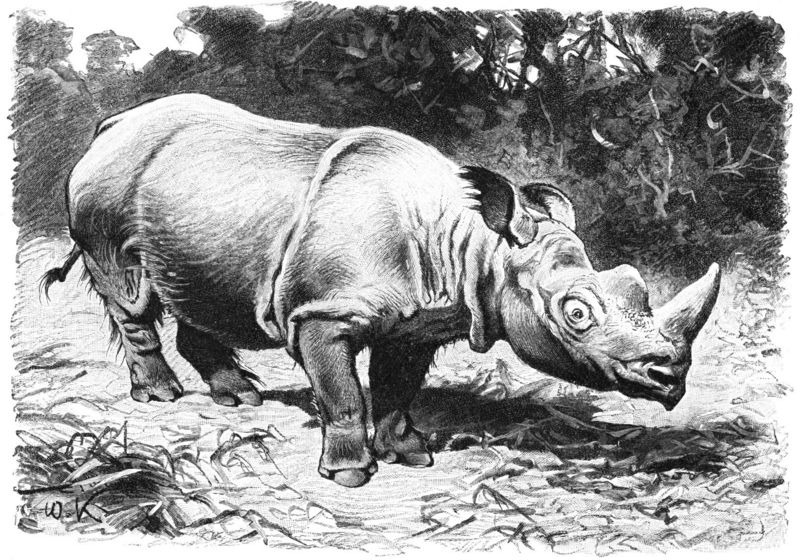Sumatran Rhinoceros (Dicerorhinus sumatrensis) - Wiki Sumatran Rhinoceros
From Wikipedia, the free encyclopedia
[Photo] Original caption: "Rauhohr-Nashorn, Dicerorhinus sumatrensis lasiotis Scl. 1/20 nat??rlicher Gr??ße. (zu S. 486.)". Translation (partly): "Sumatran rhinoceros, Dicerorhinus sumatrensis lasiotis Scl. 1/20 natural size. (see page 486.)". Size: 5.4 x 3.8 in² (13.6 x 9.5 cm²). Originator: Friedrich Wilhelm Kuhnert. Source: Brehms Tierleben, Small Edition 1927
The Sumatran Rhinoceros, Dicerorhinus sumatrensis is the smallest extant rhinoceros species, as well as the one with the most fur, which allows it to survive at very high altitudes in Borneo and Sumatra. Due to habitat loss and poaching, its numbers have declined and it is one of the world's rarest mammals. The Sumatran Rhinoceros is the last surviving species in the same group as the extinct Woolly Rhinoceros.
Anatomy
Typically a mature Sumatran Rhinoceros stands about 130 cm high at the shoulder, a body length of 240-315 cm and weighs around 700 kg, though the largest individuals have been known to weigh as much as 1,000 kilograms. Like the African species, it has two horns, the largest is the front (25-79 cm) and the smaller being the second which is usaully less than 10 cm long. The males have much larger horns than the females. Hair can range from dense (the most dense hair in young calves) to scarce and the color of these rhinos are reddish brown. The body is short and has stubby legs. They also have a prehinsile lip.
Range
Formerly, the Sumatran Rhinoceros extended in a continuous distribution as far north as Myanmar and eastern India but poaching has made it extinct in Thailand and Vietnam, whilst it has not been seen in Cambodia, Laos or Myanmar for many years. Now, they are mainly found only in Sumatra and Borneo.
Habitat
The Sumatran Rhinoceros live in lowland secondary rainforest, swamps and moss forests. It likes hilly areas close to water, particularly steep upper valleys with much undergrowth. It also lives in secondary forest where the upper canopy is broken by smaller shrubs and vines, where there is plenty of food. Recently however, the Sumatran Rhinoceros have been pushed into higher altitudes because of humans.
Behavior & Ecology
The Sumatran Rhinoceros are solitary creatures. Individuals have home ranges, bulls are around 30 square km whereas females range from 10 to 15 square km. Salt licks are essential for their home territory. Marking their territory is done by soil scrapes, bent saplings, and excrement. They eat and are most active at dawn and just after dusk. But meanwhile during the day they wallow in mudbaths to cool down and rest. These rhinos can swim very well and can easily handle steep hills. During the rainy season they go up to higher elevations and down to the valleys in the cooler months.
Feeding does occur just before nightfall and in the morning. They are browsers and have a diet of young saplings, leaves, fruits, twigs and shoots. The rhinos usaully consume up to 50 kg of food a day. Salt licks are very important to these animals. Essential nutrients are obtained from these.
Reproduction
Females become sexually mature at the age of 4-6 years, while males become sexually mature at 7-8 years old. Females only come into estrus when a male is nearby. The gestation period is around 400 days and the calve is weaned at 16-18 months and stays with the mother for 2-3 years. The birth interval for this species is 3-4 years.
Population & Threats
They were once quite numerous throughout southeast Asia. Now only about 200 individuals remain, almost all in Sundaland. It is critically endangered due to destruction of its rainforest habitat and illegal poaching. In the past decade its population has dropped 50%. Most remaining habitat is in inaccessible mountainous areas of Indonesia, where the government has shown no inclination to discourage clearing of rhino habitat for the benefit of the timber industry.
Poaching of Sumatran Rhinoceros, though less of a problem than with African Rhinoceros (at least in terms of number of animals killed), is particularly insidious because dealers who stock Sumatran Rhinoceros horn (whose price is unknown but is probably at least US$200 per gram) know that once the species becomes extinct, the price of its horn will increase exponentially. Hence, dealers wish to hasten the extinction of the species.
Attempts to replenish their numbers by breeding them in captivity have been met with difficulty. One of the few recent success stories is a female calf born on July 30, 2004 in the Cincinnati Zoo.
Subspecies
There are three subspecies:
- Eastern Sumatran Rhinoceros, Dicerorhinus sumatrensis harrissoni Once common throughout Borneo. Now only 50 indiviuals remain and all live in Sabah, Borneo. There are unconfirmed reports of animals surviving in Sarawak and Kalimantan. Logging and illegal poaching are responsible for its demise.
- Western Sumatran Rhinoceros, Dicerorhinus sumatrensis sumatrensis Only 300 animals are alive, mostly in Sumatra. The main threats against them are habitat loss and illegal poaching. There is a slight genetic difference between the Western and Eastern Sumatran Rhinos.
- Northern Sumatran Rhinoceros, Dicerorhinus sumatrensis lasiotis Once it roamed in India and Bangledesh but now are believed extinct. However unconfirmed reports suggest that there may be a very small population still surviving in Myanmar.
Sumatran Rhino on Television
NHNZ showed about one minute of a Sumatran rhino, shot by freelance Indonesian based cameraman Alain Compost, in their 2001 documentary The Forgotten Rhino, which featured mainly Javan and Indian rhinos. The BBC's Natural History Unit also showed some Sumatran rhino in their 2003 documentary The Natural World:Indonesia Fire Islands.
http://en.wikipedia.org/wiki/Sumatran_Rhinoceros
| The text in this page is based on the copyrighted Wikipedia article shown in above URL. It is used under the GNU Free Documentation License. You may redistribute it, verbatim or modified, providing that you comply with the terms of the GFDL. |
